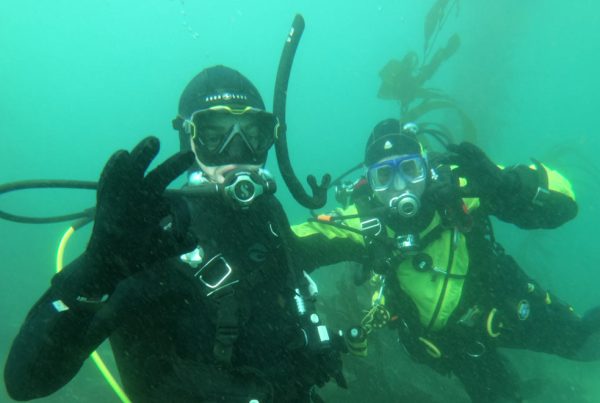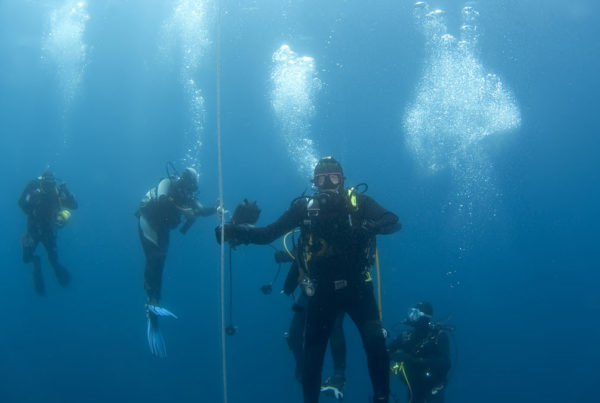To go boat diving, your choices have long been perceived as either buying your own boat or tagging along with a group, either with a club, dive store, or open boat that charters the larger commercial dive boats. Each option has its advantages and disadvantages.
Owning your own boat is the ultimate freedom, diving when, where and how you want. But it is also the ultimate responsibility. It can be expensive, you are responsible for the driving the boat safely and the diving operations off of your vessel, and then there is the hassles and costs of maintenance, insurance, and storage.
Traveling with a group on a chartered trip has the advantages of being relatively inexpensive and the safety of a supervised situation. In addition, you gain from the skill and knowledge of a professional skipper. At the end of the trip, they clean up and store the boat. If you are not particular about when and where you dive, but just want to have a great diving experience, this is your best option. When, where and how you dive is usually determined by the group leader, skipper, or both.
Another option is to dive from a charter boat on an “open boat” basis. This is where the boat opens the door to anyone wanting to participate in diving on that trip. While some open boat trips are specific to a particular skill level, many must cater to the lowest common denominator and that can be frustrating to the experienced diver looking for the more challenging dive sites. On open boats, it is usually the skipper that chooses the dive sites, but they will sometimes take suggestions or requests from the passengers.
For some individuals, however, not being able to pick a specific dive site, or day and time of dive, as well as just how they can dive (deep, shallow, hunt, etc.), can be annoying. When you dive with a group that has chartered a boat, on open boats, schedules are generally fixed and rigid. Dive locations are determined by the skipper or, at best, by the group in which you may have a small voice.
But there is a third option that is rarely pursued that has many of the advantages mentioned above with few disadvantages. By chartering a boat personally for your own dive trip you will have the advantages of going when you want to, for as long as you want to, and diving at the place you want to. You will have the services of a professional boat captain and often a divemaster and cook. There is nothing to clean up (other than your own dive gear) at the end of the trip and no boat to store. And chartering a boat for your own dive trip is easier than you think. It is also surprisingly affordable if you have a small group of friends and or family that is willing to split the costs. (If you, however, wish to charter a boat and then sell slots for profit, seriously reconsider. It is very difficult to make money selling dive trips and you open yourself up to serious liability as the “leader” of such a venture. Leave it to the pros.)
CUSTOMIZING AND FLEXIBILITY
Of the nearly three dozen charter boat operations in California, many operate quite differently with regards to what they offer, but nearly all emphasize the ability to customize on an individual charter basis. If you book the boat, you get to say when and where you want the dive trip to go. And with many, you get to say just how you want to dive. While deep, tech, or rebreather diving may be frowned upon on most dive store and club charters, if you charter the boat yourself, many will custom accommodate your particular needs
SIX PACK VS. U.S.C.G. CERTIFIED BOAT
There are two categories of charter boats available— “Six-Packs” and U.S.C.G. Certified passenger vessels. Six Packs are so called because they are authorized by the U.S. Coast Guard to carry no more than six paying passengers. In general, these boats are smaller (although not necessarily small), are not required to pass rigorous Coast Guard inspection requirements, and can be operated by skipper with a lower licence rating.
Certified passenger vessels are certified by the U.S. Coast Guard to carry a specific number of passengers (usually much more than is practical for diving operations). In California, certified vessels carry between 20 and 40 divers, with about 30 being average. The vessels undergo a rigorous inspection every two years and must meet strict standards. Captains must also have a licence to operate the vessel. And if the certified boat is out for more than 12 hours, as in an over night trip, a second licensed captain must be on board.
RATES
Obviously, if it is just you and a few buddies, a Six-Pack is your best bet. But don’t just assume it is the cheapest. Sometimes Six-Pack operations specialize in pampered service that may cost a bit more. If you charter a Six-Pack boat for the day, expect to pay $400 to $1000, sometimes more (one Six-Pack boat we spoke with would run with just two passengers to Catalina for $200, more for additional passengers). Expect to pay more to the outer islands and a premium for overnighters, although most Six-Pack boats do not do multiday trips.
Some of the smaller boats, both Six-Pack and certified, will “charter” a boat on an open-boat basis. In this case, the charge is on a per diver basis. If you want a say so on when and where the boat is going, just charter the majority of the slots on the boat. Most of the boats contacted are surprisingly flexible.
Full sized U.S. Coast Guard certified vessels go for a day rate of $1000 to as much as $2000. Many things, however, can affect these prices. Outer island trips are more and multiday excursions are not always just a multiple of the day rate. Weekday rates are cheaper than weekend rates. Weekend dates are often more difficult to book, especially in the summer and fall, as they are frequently booked far in advance by dive stores and clubs.
It is important to ask what is included. Some vessels include tanks and weights, others include food, some do not. How about air fills? Nitrox, if available, is almost always extra. Is a divemaster included? Some boats include them in the cost. Some require them but do not include them in the cost (but can provide them at an additional fee). All of these can affect your bottom line.
Do not let the higher cost of a full-sized certified boat discourage you. Even with a group as small as 10 can make a certified boat cost effective.
Your best bet at the lowest rate is mid-week (non-holiday) and during the slower months of December through February. Rates are usually not negotiable but multiple repeat customers might be able to work something out. Some boats, with open-boat specials, work on a “buy so many slots on an open boat and get one free” basis.
Another way to reduce your upfront costs on chartering your own boat is to charter just half the boat. Not all boats allow this (especially Six-Packs), and you will be sharing your collective will with another entity, but it is an option. Another option available with some boats is half-day charters. This works especially well with boats that have nearby destinations where you can easily get in two or three dives in four hours.
Chartering a professional dive boat has many advantages of convenience, ease, and it is surprisingly affordable. If you want to do some serious diving this summer, with a great deal of freedom, charter a pro dive boat. You will not be disappointed.










